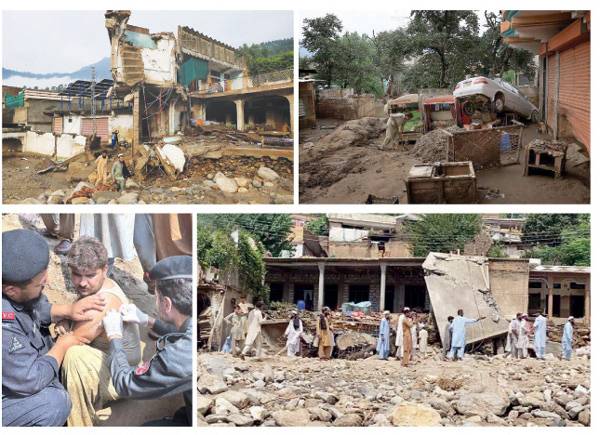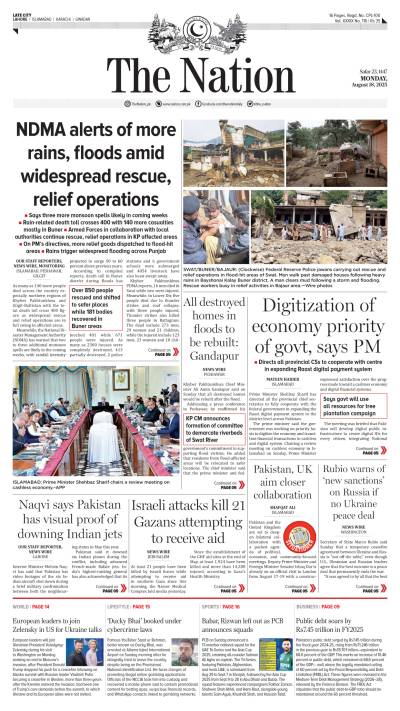Says three more monsoon spells likely in coming weeks Rain-related death toll crosses 400 with 140 more casualties mostly in Buner Armed Forces in collaboration with local authorities continue rescue, relief operations in KP affected areas On PM’s directives, more relief goods dispatched to flood-hit areas Rains trigger widespread flooding across Punjab.
ISLAMABAD, PESHAWAR, GILGIT - As many as 140 more people died across the country especially northern regions of Khyber Pakhtunkhwa and Gilgit-Baltistan with the total death toll cross 400 figure as widespread rescue and relief operations are in full swing in affected areas.
Meanwhile, the National Disaster Management Authority (NDMA) has warned that two to three additional monsoon spells are likely in the coming weeks, with rainfall intensity projected to surge 50 to 60 percent above previous years.
According to compiled reports, death toll in Buner district during floods has touched 401 while 671 people were injured. As many as 2300 houses were completely destroyed, 413 partially destroyed. 2 police stations and 6 government schools were submerged and 4054 livestock have also been swept away.
Khyber Pakhtunkhwa PDMA reports, 16 men died in Swat while two were injured. Meanwhile, in Lower Dir, five people died due to thunder strikes and roof collapse, with three people injured. Thunder strikes also killed three people in Battagram. The dead include 273 men, 29 women and 21 children, while the injured include 123 men, 23 women and 10 children, the PDMA stated. The NDMA, in coordination with the Armed Forces and over a dozen national and international welfare organizations, continues to dispatch relief goods to flood-affected areas of Khyber Pakhtunkhwa.
NDMA officials said, the ongoing operation includes the delivery of food supplies, tents, medical kits, and other essential items to communities impacted by recent monsoon-triggered flooding. The organization is extending full support to the Khyber Pakhtunkhwa government and the Provincial Disaster Management Authority (PDMA).
Armed forces are assisting in ongoing relief and rescue operations. A detailed survey, in coordination with provincial governments, will be conducted to assess exact losses. Relief camps will be established if necessary to provide shelter and support to displaced communities.
Alkhidmat Foundation has dispatched ration bags, cooked meals, clean drinking water, dry milk, and water tankers to affected areas.
Helping Hands has contributed food and clean drinking water. Meanwhile, the Pakistan Red Crescent Society (PRCS) has deployed ambulances, distributed food and tents, and set up medical camps to provide treatment.
Islamic Relief has mobilized volunteers to assist in rescue and relief operations. Penny Appeal has supplied food and clean drinking water to affected communities.
In a joint effort, WHH and IDEA have provided relief goods valued at 50,000 euros. The Rural Development Organization has established a medical camp in Pir Baba Bazaar to deliver essential healthcare services.
The Edhi Foundation has dispatched ambulances to support emergency response in affected areas. The Environmental Protection Society has supplied food and clean drinking water. KS Relief has distributed relief kits, while Secours Islamique France has provided tents, hygiene kits, and kitchen sets to assist displaced families.
According to NDMA data, at least 657 people, including 392 men, have lost their lives in rain-related incidents across Pakistan since June 26, while 929 others have been injured.
The casualties have resulted from widespread monsoon rains, flash floods, and associated hazards affecting multiple regions. The NDMA said it is working closely with provincial authorities to accelerate relief and rescue efforts in the worst-affected areas.
The national death toll from rain-related incidents has climbed to 657 since June 26, with Khyber Pakhtunkhwa bearing the brunt of the devastation, official data reveals.
Of the total nationwide casualties, 171 were children, 94 were women, and 392 were men.
Khyber Pakhtunkhwa alone accounted for 390 deaths, including 288 men, 59 children, and 43 women — underscoring the province’s disproportionate vulnerability to seasonal downpours and related hazards.
In Punjab, 164 people have died in rain-related incidents since June 26, with children comprising the largest share of casualties. The province reported 70 child fatalities, alongside 63 men and 31 women, mostly in vulnerable and low-lying areas.
Sindh has recorded 28 deaths linked to ongoing monsoon activity, including 14 children, 10 men, and 4 women. Authorities have urged residents in high-risk zones to exercise caution as weather conditions remain unpredictable.
According to the NDMA, 20 people have died in Balochistan, including 11 children, 5 men, and 4 women. In Gilgit-Baltistan, the death toll has reached 32, comprising 18 men, 6 women, and 8 children.
Balochistan reported 20 fatalities, including 11 children, 5 men, and 4 women.
In Gilgit-Baltistan, 32 deaths were recorded — 18 men, 8 children, and 6 women.
Azad Jammu and Kashmir saw 15 casualties, evenly split among 5 children, 5 men, and 5 women.
An additional 8 deaths occurred in rain-related incidents in Islamabad Capital Territory (ICT), comprising 4 children, 3 men, and 1 woman.
Addressing a media briefing on rain-related damages and flood response in Islamabad, NDMA Chairman Lt Gen Inam Haider warned that two to three additional monsoon spells are likely in the coming weeks, with rainfall intensity projected to surge 50 to 60 percent above previous years.
He said this year’s monsoon spread has expanded significantly due to unusually high summer temperatures, which triggered atmospheric instability and heavier rainfall across multiple regions.
He attributed the heightened severity to climate change, which continues to intensify weather disruptions in vulnerable regions. Pakistan is witnessing severe repercussions, with widespread destruction reported in Buner, Bajaur and Battagram areas increasingly exposed to climate-driven hazards.
“The monsoon season is expected to persist until September 10,” he said.
Lt Gen Haider said land connectivity has been severed with several settlements in Gilgit-Baltistan and Khyber Pakhtunkhwa due to flash floods and landslides. Search operations for missing persons are ongoing, while relief goods and food supplies are being dispatched to affected districts.
Restoration work is underway in areas where link roads have been damaged. NDMA remains in constant coordination with provincial governments to ensure timely assistance and effective response.
The NDMA chairman emphasized that all available resources will be mobilized to minimize potential flood-related losses. Vulnerable areas will be evacuated in advance to safeguard lives, while communication networks in cut-off regions will be restored on a priority basis through technical teams.
The restoration drive will prioritize reconnecting isolated regions and is expected to be completed before the onset of the next monsoon cycle.
Earlier, officials from the NDMA briefed the media on a comprehensive monsoon contingency plan, identifying regions most vulnerable to heavy rainfall and potential flooding. According to the briefing, northeastern areas — including Azad Jammu and Kashmir and central Khyber Pakhtunkhwa — along with southeastern districts such as Tharparkar, Sujawal, Tando Allah Yar, Tando Muhammad Khan, and Badin are likely to experience intensified monsoon activity.
The NDMA highlighted that three major weather systems are currently converging over Pakistan, which is expected to significantly amplify rainfall across the country
NDMA General Manager Zahra Hassan stated that heavy rainfall is expected within the next 24 to 48 hours, warning that Tarbela Dam is currently at 98 percent capacity and may reach a critical level during this period. She further noted that water levels have risen by up to 15 feet at Katarian and Gwalmandi bridges along Nullah Leh.
A new rainfall sequence has commenced in areas along the Koh-e-Suleiman mountain range. Flood risks have escalated in Azad Jammu and Kashmir’s Neelum, Poonch, and Bagh districts. In Khyber Pakhtunkhwa, vulnerable areas include Peshawar, Chitral, Dir, and Charsadda, where flood threats remain particularly high.
A total of 159 houses have been damaged — 62 of them fully — while 57 schools across KP have also been partially damaged.
According to initial details from the Buner Deputy Commissioner’s Office, machinery has been deployed to the affected areas. “However, due to continuous heavy rainfall, it is currently impossible to reopen the causeway at Gadezai.”
More than 850 people have been rescued and shifted to safer places while 181 bodies have been recovered in Buner’s districts of Gaddizi, Bishoni, Malikpur, Balokhan and other nearby areas which were worst affected.
“Dozens of houses in different districts have been reduced to rubble; agricultural lands and infrastructure have been severely damaged, while reports of loss of life are also alarming,” the PDMA update said.
In Daggar, the capital of Buner, 30 people died in Gokand, Kot and other districts, while 202 people, including women and children, were shifted to safer places.
A total of 41 bodies were recovered from Chagharzai while 35 people were rescued in injured condition and taken to the Rural Health Centre Hospital Gulbandi.
Three bodies were also recovered from the Salmani area of Mandanr and shifted to the district headquarters hospital.
“Buner Rescue 1122 personnel are continuously engaged in search and rescue operations day and night in the affected areas,” the statement said.
“Rescue personnel and emergency vehicles from Swabi have also joined the operation, while special rescue teams from Peshawar are also participating in relief activities in the affected areas.”
Rescue teams and district officials are continuously present in the field and on high alert to provide timely assistance to the affected people, it added.
Meanwhile, on the special instructions of Prime Minister Shehbaz Sharif, additional relief goods were being dispatched to the flood-affected areas.
On the prime minister’s directives, federal ministers will participate in relief operations in the flood-hit districts of Khyber Pakhtunkhwa.
As per the prime minister’s instructions, Federal Minister for Kashmir Affairs and Gilgit-Baltistan Engineer Amir Muqam will oversee the distribution of relief goods in districts Shangla and Buner; Federal Minister for Power Division will assist in Buner; Federal Minister for Religious Affairs Sardar Yousaf will oversee operations in Mansehra and PM’s Special Assistant Mubarak Zeb will supervise aid distribution in Bajaur.
The prime minister was personally overseeing NDMA’s relief operations in all flood-affected districts of Khyber Pakhtunkhwa, PM Office Media Wing, on Sunday, said in a press release.
Under the PM’s Relief Package, more truckloads with relief supplies were being dispatched to the affected districts.
The relief goods included food rations, tents, and medicines. These items were being handed over to the district administrations.
The prime minister has instructed the Chairman NDMA to stay in constant contact with the disaster management authorities of Khyber Pakhtunkhwa, Gilgit-Baltistan, and Azad Jammu and Kashmir to make relief activities more coordinated.
Meanwhile, Gilgit-Baltistan (GB) government spokesperson Faizullah Faraq told the media that the Karakoram Highway, blocked four days ago due to floods in Kohistan, was restored and opened for all types of traffic.
“The Karakoram Gilgit-Rawalpindi section has been opened,” he said. “With the restoration of the highway, vehicles, passengers and tourists stranded in Gilgit and Rawalpindi have left for their destinations.”
According to the Punjab Disaster Management Authority (PDMA), heavy monsoon rains have pushed river levels across Punjab to dangerous highs, inundating villages, destroying crops, and cutting off ground access in several districts. Local authorities have established flood relief camps, while rescue teams continue evacuations as the Meteorological Department warns of further rainfall and flash flooding over the coming days.
The province is currently experiencing the seventh spell of monsoon rains, which is forecast to continue until Aug. 23.
Officials cautioned that cloudbursts remain possible in Rawalpindi, Murree, Galliyat, Jhelum, Chakwal, and Attock, while heavy downpours are expected across major urban centers including Lahore, Sialkot, Faisalabad, and Multan.
In Kasur, the Sutlej River has risen sharply, submerging dozens of villages and vast tracts of farmland. PDMA officials reported water discharge at the Ganda Singh Wala headworks reached 75,000 cusecs. Authorities warned that additional water releases from India’s Harike Headworks could intensify flooding, further endangering communities downstream.








